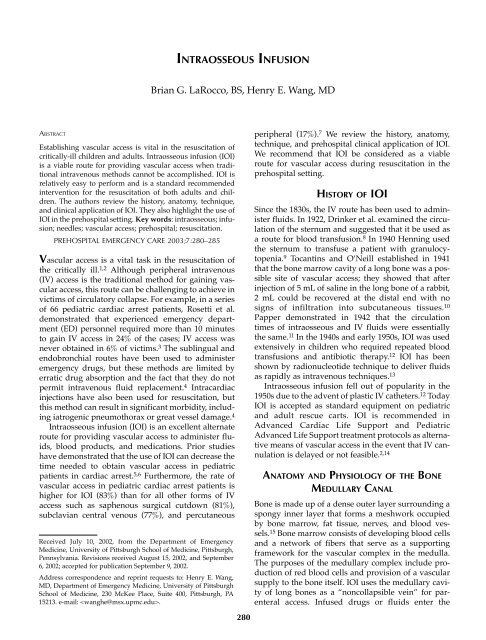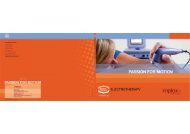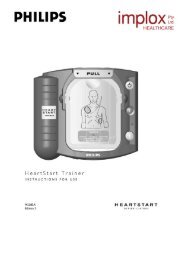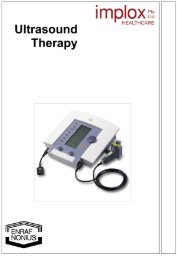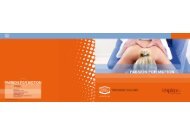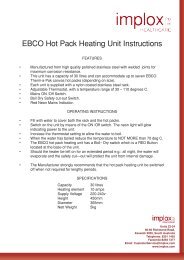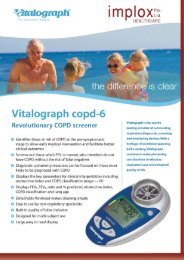intraosseous infusion - Implox
intraosseous infusion - Implox
intraosseous infusion - Implox
Create successful ePaper yourself
Turn your PDF publications into a flip-book with our unique Google optimized e-Paper software.
INTRAOSSEOUS INFUSION<br />
Brian G. LaRocco, BS, Henry E. Wang, MD<br />
ABSTRACT<br />
Establishing vascular access is vital in the resuscitation of<br />
critically-ill children and adults. Intraosseous <strong>infusion</strong> (IOI)<br />
is a viable route for providing vascular access when traditional<br />
intravenous methods cannot be accomplished. IOI is<br />
relatively easy to perform and is a standard recommended<br />
intervention for the resuscitation of both adults and children.<br />
The authors review the history, anatomy, technique,<br />
and clinical application of IOI. They also highlight the use of<br />
IOI in the prehospital setting. Key words: <strong>intraosseous</strong>; <strong>infusion</strong>;<br />
needles; vascular access; prehospital; resuscitation.<br />
PREHOSPITAL EMERGENCY CARE 2003;7:280–285<br />
Vascular access is a vital task in the resuscitation of<br />
the critically ill. 1,2 Although peripheral intravenous<br />
(IV) access is the traditional method for gaining vascular<br />
access, this route can be challenging to achieve in<br />
victims of circulatory collapse. For example, in a series<br />
of 66 pediatric cardiac arrest patients, Rosetti et al.<br />
demonstrated that experienced emergency department<br />
(ED) personnel required more than 10 minutes<br />
to gain IV access in 24% of the cases; IV access was<br />
never obtained in 6% of victims. 3 The sublingual and<br />
endobronchial routes have been used to administer<br />
emergency drugs, but these methods are limited by<br />
erratic drug absorption and the fact that they do not<br />
permit intravenous fluid replacement. 4 Intracardiac<br />
injections have also been used for resuscitation, but<br />
this method can result in significant morbidity, including<br />
iatrogenic pneumothorax or great vessel damage. 4<br />
Intraosseous <strong>infusion</strong> (IOI) is an excellent alternate<br />
route for providing vascular access to administer fluids,<br />
blood products, and medications. Prior studies<br />
have demonstrated that the use of IOI can decrease the<br />
time needed to obtain vascular access in pediatric<br />
patients in cardiac arrest. 5,6 Furthermore, the rate of<br />
vascular access in pediatric cardiac arrest patients is<br />
higher for IOI (83%) than for all other forms of IV<br />
access such as saphenous surgical cutdown (81%),<br />
subclavian central venous (77%), and percutaneous<br />
Received July 10, 2002, from the Department of Emergency<br />
Medicine, University of Pittsburgh School of Medicine, Pittsburgh,<br />
Pennsylvania. Revisions received August 15, 2002, and September<br />
6, 2002; accepted for publication September 9, 2002.<br />
Address correspondence and reprint requests to: Henry E. Wang,<br />
MD, Department of Emergency Medicine, University of Pittsburgh<br />
School of Medicine, 230 McKee Place, Suite 400, Pittsburgh, PA<br />
15213. e-mail: .<br />
280<br />
peripheral (17%). 7 We review the history, anatomy,<br />
technique, and prehospital clinical application of IOI.<br />
We recommend that IOI be considered as a viable<br />
route for vascular access during resuscitation in the<br />
prehospital setting.<br />
HISTORY OF IOI<br />
Since the 1830s, the IV route has been used to administer<br />
fluids. In 1922, Drinker et al. examined the circulation<br />
of the sternum and suggested that it be used as<br />
a route for blood transfusion. 8 In 1940 Henning used<br />
the sternum to transfuse a patient with granulocytopenia.<br />
9 Tocantins and O’Neill established in 1941<br />
that the bone marrow cavity of a long bone was a possible<br />
site of vascular access; they showed that after<br />
injection of 5 mL of saline in the long bone of a rabbit,<br />
2 mL could be recovered at the distal end with no<br />
signs of infiltration into subcutaneous tissues. 10<br />
Papper demonstrated in 1942 that the circulation<br />
times of <strong>intraosseous</strong> and IV fluids were essentially<br />
the same. 11 In the 1940s and early 1950s, IOI was used<br />
extensively in children who required repeated blood<br />
transfusions and antibiotic therapy. 12 IOI has been<br />
shown by radionucleotide technique to deliver fluids<br />
as rapidly as intravenous techniques. 13<br />
Intraosseous <strong>infusion</strong> fell out of popularity in the<br />
1950s due to the advent of plastic IV catheters. 12 Today<br />
IOI is accepted as standard equipment on pediatric<br />
and adult rescue carts. IOI is recommended in<br />
Advanced Cardiac Life Support and Pediatric<br />
Advanced Life Support treatment protocols as alternative<br />
means of vascular access in the event that IV cannulation<br />
is delayed or not feasible. 2,14<br />
ANATOMY AND PHYSIOLOGY OF THE BONE<br />
MEDULLARY CANAL<br />
Bone is made up of a dense outer layer surrounding a<br />
spongy inner layer that forms a meshwork occupied<br />
by bone marrow, fat tissue, nerves, and blood vessels.<br />
15 Bone marrow consists of developing blood cells<br />
and a network of fibers that serve as a supporting<br />
framework for the vascular complex in the medulla.<br />
The purposes of the medullary complex include production<br />
of red blood cells and provision of a vascular<br />
supply to the bone itself. IOI uses the medullary cavity<br />
of long bones as a “noncollapsible vein” for parenteral<br />
access. Infused drugs or fluids enter the
LaRocco and Wang IO INFUSION 281<br />
FIGURE 1. Anatomy of long bone circulation and landmarks for<br />
<strong>intraosseous</strong> needle insertion (access site) on the proximal tibia.<br />
venous sinusoids within the medullary cavity, drain<br />
into the central venous channel, and exit the bone via<br />
nutrient or emissary veins (Figure 1).<br />
INDICATIONS AND CONTRAINDICATIONS<br />
The basic indication for IOI is the need for emergent<br />
vascular access when conventional methods have<br />
failed. The American Heart Association recommends<br />
the use of IOI in patients under 6 years of age in need<br />
of vascular access who have had two failed IV<br />
attempts or where more than 2 minutes have elapsed<br />
at attempting IV access. 6 Advanced Trauma Life<br />
Support protocols recommend the use IOI before central<br />
line insertion in pediatric trauma patients younger<br />
than age 6. 2 The use of IOI in major trauma in pediatric<br />
patients regardless of age has also been supported<br />
by Guy et al. 16 IOI has also been recommended for<br />
conditions such as cardiopulmonary arrest, profound<br />
shock, status epilepticus, overwhelming sepsis, and<br />
major burns. 17,18<br />
The only universally accepted absolute contraindication<br />
to IOI is a fracture of the bone near the access<br />
site. 19 Some authors feel that osteogenesis imperfecta<br />
and osteoporosis should also be considered absolute<br />
contraindications. 20 Relative contraindications to IOI<br />
include cellulitis over the insertion site and inferior<br />
vena caval injury. 19<br />
TECHNIQUES OF INSERTION AND INFUSION<br />
The conventionally recommended site for IOI is the<br />
proximal tibia. 2 The tibial tuberosity should be located<br />
by palpation just below the patella. The recommended<br />
insertion site is the relatively flat area approximately 2<br />
cm distally and slightly medial to the tibial tuberosity<br />
(Figures 1 and 2). Although this site is usually distal to<br />
the growth plate, it is still recommended that the nee-<br />
FIGURE 2. Technique of <strong>intraosseous</strong> needle insertion in the proximal<br />
tibia.
282 PREHOSPITAL EMERGENCY CARE APRIL / JUNE 2003 VOLUME 7 / NUMBER 2<br />
FIGURE 3. The Jamshidi Illinois bone marrow needle (Baxter<br />
Allegiance, Inc., McGaw Park, Illinois).<br />
dle be angled 10–15 degrees caudally to avoid injury<br />
to the growth plate.<br />
The patient’s leg should be restrained and a small<br />
sandbag placed under the knee (Figure 2). The area<br />
should be cleaned and draped using sterile technique.<br />
Local anesthetic is recommended in the conscious<br />
patient (1% lidocaine injected subcutaneously and<br />
over the periosteum). The IO needle is inserted<br />
through the skin and subcutaneous tissues until bone<br />
is felt. The needle is then inserted into the bone using<br />
a twisting motion until a loss of resistance or “pop” is<br />
felt, indicating entry into the marrow. The trocar is<br />
removed from the needle and proper placement is verified.<br />
Any conventional IV fluid and IV tubing may be<br />
connected to the IO needle. The protruding IO needle<br />
should be covered and protected; for example, by<br />
using a properly sized plastic or paper cup.<br />
Proper IO placement in the marrow canal can be<br />
confirmed by three methods. First, the needle should<br />
stand on its own without support. Second, after<br />
unscrewing the inner trocar from the needle, bone marrow<br />
should be able to be aspirated through the needle.<br />
Third, a 5–10-mL saline bolus injection should enter<br />
with little resistance and without evidence of extravasation;<br />
this can be confirmed by carefully observing the<br />
calf area for acute swelling or discoloration.<br />
Only one IO attempt should be made in each bone.<br />
Multiple punctures in the periosteum may result in<br />
extravasation of fluid into the soft tissues. However, if<br />
the needle becomes plugged with soft tissue, it may be<br />
removed, and a new needle may be inserted through<br />
the same cannulation site. 4<br />
There are several alternative sites for IOI. 4 The distal<br />
tibia is an acceptable alternate placement site in<br />
children. To avoid the saphenous vein, the distal tibia<br />
may be entered 1–2 cm superior to the medial malleolus.<br />
As with the proximal tibia, the needle should be<br />
angled (10–15 degrees) away from the growth plate<br />
(i.e., cephalad in this instance). A case report has<br />
demonstrated the successful use of the calcaneus as an<br />
alternative IOI site. 21 The sternum has fallen out of<br />
favor in the pediatric emergency setting because it<br />
interferes with resuscitative efforts and carries a risk<br />
of mediastinal injury, pneumothorax, great vessel<br />
injury, and death. 20 However, new auto-injector<br />
devices have improved the safety of sternal access,<br />
making this site an attractive option for IOI (see Types<br />
of IO Needles and Alternative IO Devices, below).<br />
Virtually all drugs that can be administered via the<br />
IV route can be administered by IOI. 1 Fluids and medications<br />
such as epinephrine, sodium bicarbonate, calcium<br />
chloride, hydroxyethyl starch, 50% dextrose in<br />
water, and lidocaine have all been shown to have drug<br />
levels and peak effects equivalent to the IV route, with<br />
an equivalent or longer duration of action. 22,23 Warren<br />
et al. demonstrated in pigs that different IOI sites<br />
(humerus, femur, malleolar, and tibia) are pharmacokinetically<br />
equivalent with regard to transit times and<br />
serum concentrations. 24 Therefore, it is not necessary<br />
to adjust drug dosages based on the IOI insertion site.<br />
Although fluids may infuse by gravity, Voelckel et<br />
al. demonstrated the unpredictability of bone marrow<br />
blood flow by this method alone; they concluded that<br />
it was necessary to use pressure to augment flow in<br />
IOI. 25 Flow rates can be dramatically increased by the<br />
use of pressure bags and <strong>infusion</strong> pumps. Flow rates<br />
of 10 mL/min by gravity can be increased to 41<br />
mL/min by using pressurized bags. 26 An alternative<br />
method for rapid <strong>infusion</strong> is to manually infuse 30–60-<br />
mL boluses via a stopcock.<br />
Blood aspirated from the IOI site may be used for<br />
certain laboratory analyses. Hurren demonstrated that<br />
when comparing blood drawn from a venous site with<br />
blood from an IO site, hemoglobin, hematocrit, sodium,<br />
urea, creatinine, and calcium levels were “sufficiently<br />
similar to be clinically useful.” 27 However,<br />
potassium and glucose levels were significantly variable<br />
in the bone marrow sample as compared with the<br />
venous sample.<br />
TYPES OF IO NEEDLES AND<br />
ALTERNATIVE IO DEVICES<br />
Any needle can be used for IOI, including a butterfly<br />
needle, a spinal needle with stylet, or a standard bone<br />
marrow biopsy needle such as the Cook Osteo-Site<br />
(Cook Critical Care, Bloomington, IN). 28 For these needles,<br />
a 16–20-gauge needle is recommended for children<br />
less than 18 months and 12–16-gauge for older<br />
children. 4 There are also needles designed specifically<br />
for IOI. These needles have trocars with handles to<br />
allow more controlled pressure and short shafts to<br />
make placement easier and accidental dislodging less<br />
likely. Also, they may be marked to indicate desired<br />
depth of penetration. Examples of standard IOI needles<br />
include the straight-needle Jamshidi (Baxter<br />
Allegiance, Inc., McGaw Park, IL, Figure 3) and<br />
Dieckmann (Cook Critical Care). The newer Sur-Fast<br />
(Cook Critical Care) and Sussmane-Raszynski (Cook
LaRocco and Wang IO INFUSION 283<br />
Critical Care, Figure 4) contain threaded needles that<br />
facilitate needle insertion into bone.<br />
Spring-loaded auto-injector IO devices have been<br />
recently developed that facilitate easier and quicker IO<br />
needle placement. For example, the bone injection gun<br />
(BIG, WaisMed, Tri-anim, Sylmar, CA) is a springloaded<br />
auto-injection device (Figure 5). Depth of insertion<br />
can be controlled by the device. Spriggs et al.<br />
showed that emergency medical technician trainees<br />
found the BIG to be faster (12 sec vs. 17 sec) but similar<br />
in ease of use to the traditional Jamshidi IOI needle. 29<br />
However, Gilman et al. found no difference between<br />
traditional IO needles and the BIG with respect to<br />
placement time and success rate. 30 When compared<br />
with saphenous vein cutdown, paramedic students<br />
found the BIG to have a shorter time to insertion, a<br />
higher success rate, and fewer complications. 31<br />
The F.A.S.T.1 (Pyng Medical Corporation,<br />
Vancouver, BC, Canada) uses the sternum for IO<br />
access (Figure 6). It employs a target patch to ensure<br />
proper location (15 mm below the sternal notch) and<br />
an introducer with a predetermined depth setting to<br />
prevent overpenetration of the sternum. It can provide<br />
flow rates ranging from 30 mL/min (gravity) to 125<br />
mL/min (pressure cuff or syringe bolus). 32 F.A.S.T.1 is<br />
similar to other IOI techniques with regard to mean<br />
insertion time (77 seconds) and overall adult vascular<br />
access success rate (84%). 33 Astudy comparing the<br />
BIG, Sur-Fast, Jamshidi, and F.A.S.T.1 found all<br />
devices to have similar success rates and access times;<br />
however, F.A.S.T.1 was slower to insert. All devices<br />
were rated as easy to learn, but the BIG was rated as<br />
the first or second choice in 65%. 34<br />
COMPLICATIONS<br />
The risks and complications of IOI are rare and outweighed<br />
by the benefits of immediate vascular access<br />
for administration of fluids or medications.<br />
Extravasation of fluid is the most common complication;<br />
this may occur from a misplaced needle, from<br />
FIGURE 4. The Sussmane-Razynski needle (Cook Critical Care, Inc.,<br />
Bloomington, Indiana).<br />
FIGURE 5. The bone injection gun (BIG—WaisMed, Tri-anim,<br />
Sylmar, California).<br />
multiple attempts in the same bone, or from movement<br />
of the needle enlarging the penetration site. If<br />
caustic medications are being infused (for example,<br />
dopamine), this may lead to necrosis of muscle and<br />
other subcutaneous tissues. Extravasation may also<br />
precipitate compartment syndrome leading to a<br />
potential loss of limb. Osteomyelitis is a rare complication,<br />
occurring in 0.6% of cases 3 ; this occurs most<br />
frequently with prolonged needle placement, preexisting<br />
bacteremia, and the use of hypertonic fluids.<br />
Promptly replacing the IO needle with conventional<br />
peripheral or central venous access may minimize<br />
these complications.<br />
Rarely, fractures at the insertion site, compartment<br />
syndrome, fat emboli, cellulitis, and local abscess have<br />
occurred. 35,36 The theoretical complication of injury to<br />
the epiphyseal growth plate has not been supported<br />
by long-term prospective radiographic analyses of tibial<br />
length. Fiser et al. followed ten subjects radiographically<br />
to evaluate tibial length discrepancy one<br />
or more years after IOI; they found no difference<br />
between the lengths of the tibias with and without the<br />
IOI. 37 IOI has not been demonstrated to cause histologic<br />
damage to metaphyseal cell lines or morphologic<br />
damage to the growth plate of rabbits. 38<br />
USE OF IOI IN ADULTS<br />
The use of IOI in adults is an area of much debate.<br />
Vascular red marrow is typically replaced by fat-laden<br />
yellow marrow by age 5, suggesting that children<br />
under age 6 are the best candidates for IOI. 20 Many<br />
authors feel that adults are not suitable candidates for<br />
IOI because of the increased difficulty of needle insertion<br />
through the thicker cortex of bone and smaller<br />
marrow cavity; this may lead to an increase in complications,<br />
especially fractures. 39 Although there is conjecture<br />
that the relative lack of red bone marrow in the<br />
adult may limit <strong>infusion</strong> rates, modest <strong>infusion</strong> rates<br />
of 20–25 mL/min using fluid bolus injection techniques<br />
have been achieved. 40<br />
Because the sternum retains a relatively large proportion<br />
of its red marrow, IOI can be accomplished
284 PREHOSPITAL EMERGENCY CARE APRIL / JUNE 2003 VOLUME 7 / NUMBER 2<br />
Jamshidi modified Illinois, SAVE sternal screw<br />
(Biologix, Sausalito, CA), and F.A.S.T.1 have improved<br />
the safety of this technique.<br />
The BIG has been used successfully in adult<br />
extremity bones. Waisman and Waisman demonstrated<br />
that the BIG provided a higher success rate of vascular<br />
access when compared with manual IO insertion<br />
of a trocar needles in adult patients. 41<br />
PREHOSPITAL APPLICATION OF IOI<br />
Intraosseous <strong>infusion</strong> is appropriate for the prehospital<br />
setting. Although prehospital training curricula<br />
focusing on pediatrics have improved vascular access<br />
time in young children, IV access still occasionally<br />
cannot be accomplished, and thus there is still a need<br />
for alternate vascular access options. 42–44 The use of<br />
IOI in the prehospital setting has not been universally<br />
accepted because of reservations that prehospital personnel<br />
will not be proficient with the procedure.<br />
However, many studies have demonstrated that paramedic<br />
and flight nurses have applied pediatric IOI<br />
with rates of successful placement ranging from 76%<br />
to 94%. 20,45–47<br />
Anderson et al. demonstrated that prehospital<br />
providers could successfully learn IOI techniques with<br />
only a one-hour standardized training session including<br />
a 20-minute video presentation followed by a<br />
supervised hands-on simulation with chicken bones. 48<br />
Furthermore, it has been shown that IOI can also be<br />
successfully and rapidly inserted en route to the hospital.<br />
49 Although concerns exist regarding the ability to<br />
maintain proficiency in IOI, Glaeser et al. demonstrated<br />
that proficiency could be maintained over a fiveyear<br />
period with minimal training. 46 Despite the<br />
potential for IOI use in the prehospital setting, less<br />
than half of state emergency medical services (EMS)<br />
systems have reported actual prehospital field application.<br />
50 One-third of state EMS services were unaware<br />
of future plans to introduce IOI to EMS practice. 50<br />
FIGURE 6. The F.A.S.T.1 system. Source: Pyng Medical Corporation,<br />
Vancouver, BC, Canada (www.pyng.com/pym/products/description.htm).<br />
through the sternum in adults. 15 The recommended<br />
<strong>infusion</strong> site on the sternum is in the midline of the<br />
manubrium, 15 mm below the sternal notch; this<br />
offers a large, flat, easily accessible surface that has a<br />
relatively thin bone covering for easier penetration. 32<br />
The sternum is also less likely to fracture than extremity<br />
bones. 15 Newer needles and placement systems<br />
specifically designed for the sternum such as the<br />
CONCLUSION<br />
Although it is an accepted route for emergency vascular<br />
access, <strong>intraosseous</strong> <strong>infusion</strong> is still not in widespread<br />
clinical use. The recent advent of new technology<br />
have greatly simplified and improved the safety<br />
of the procedure. IOI is a viable method for emergent<br />
vascular access in the prehospital setting.<br />
References<br />
1. Hazinski MF, Cummins RO, Field JM (eds).Basic life support for<br />
health care providers. In: Handbook of Emergency Cardiovascular<br />
Care for Healthcare Providers. Dallas TX: American Heart<br />
Association, 2002, pp 1-2, 96.<br />
2. American College of Surgeons (eds). ATLS, Advanced Trauma<br />
Life Support for Doctors, Student Manual. Chicago IL:<br />
American College of Surgeons, 1997, pp 12, 97.
LaRocco and Wang IO INFUSION 285<br />
3. Rosetti V, Thompson BM, Aprahamian C, Darin JC, Mateer JR.<br />
Difficulty and delay in intravascular access in pediatric arrests<br />
[abstract]. Ann Emerg Med. 1984;13:406.<br />
4. Neal CJ, McKinley DF. Intraosseous <strong>infusion</strong> in pediatric<br />
patients. J Am Osteopath Assoc. 1994;94(1):63-6.<br />
5. Glaeser PW, Losek JD, Nelson DB, et al. Pediatric <strong>intraosseous</strong><br />
<strong>infusion</strong>s: impact on vascular access time. Am J Emerg Med.<br />
1988;6:330-2.<br />
6. Kanter RK, Zimmerman JJ, Strauss RH, Stoeckel KA. Pediatric<br />
emergency intravenous access: evaluation of a protocol. Am J<br />
Dis Child. 1986;140:132-4.<br />
7. Brunette DD, Fischer R. Intravenous access in pediatric cardiac<br />
arrest. Am J Emerg Med. 1988;6:577-9.<br />
8. Drinker CK, Drinker KR, Lund CC. The circulation of the mammalian<br />
bone marrow. Am J Physiol. 1922;62:1-92.<br />
9. Henning N. Intrasternal injections and transfusions [abstract].<br />
JAMA. 1945;128:240.<br />
10. Tocantins L, O’Neill J. Infusions of blood and other fluids into<br />
the general circulation via the bone marrow. Surg Gynecol<br />
Obstet. 1941;73:281-7.<br />
11. Papper EM. Bone marrow route for injecting fluids and drugs<br />
into the general circulation. Anesthesiology. 1942;3:307-13.<br />
12. Rosetti VA, Thompson BM, Miller J, Mateer JR, Aprahamian C.<br />
Intraosseous <strong>infusion</strong>: an alternative route of pediatric intravascular<br />
access. Ann Emerg Med. 1985;14:885-8.<br />
13 Cameron JL, Fontanarosa PB, Passalaqua AM. A comparative<br />
study of peripheral to central circulation delivery times between<br />
<strong>intraosseous</strong> and intravenous injection using radionucleotide<br />
technique in normovolemic and hypovolemic canines. J Emerg<br />
Med. 1989;7:123-7 .<br />
14. Chameides L, Hazinski MF (eds). Intraosseous Cannulation. In:<br />
Textbook of Pediatric Advanced Life Support. Dallas TX:<br />
American Association of Pediatrics–American Heart Association,<br />
1994, pp 5-6.<br />
15. Ross MH, Romrell LJ, Kaye GI. Histology: A Text and Atlas,<br />
Third Ed. Baltimore, MD: Williams & Wilkins, 1995, pp 150-3.<br />
16. Guy J, Haley K, Zuspan SJ. Use of <strong>intraosseous</strong> <strong>infusion</strong> in the<br />
pediatric trauma patient. J Pediatr Surg. 1993;28:158-61.<br />
17. Hurren JS, Dunn KW. Intraosseous <strong>infusion</strong> for burn resuscitation.<br />
Burns. 1995;21:285-7.<br />
18. Goldstein B, Doody D, Briggs S. Emergency <strong>intraosseous</strong> <strong>infusion</strong><br />
in severely burned children. Pediatr Emerg Care. 1990;<br />
6:1995-7.<br />
19. Miner WF, Corneli HM, Bolte RG, Lehnhof D, Clawson JJ.<br />
Prehospital use of <strong>intraosseous</strong> <strong>infusion</strong> by paramedics. Pediatr<br />
Emerg Care. 1989;5(1):5-7 .<br />
20. Fiser DH. Intraosseous <strong>infusion</strong>. N Engl J Med. 1990;322:1579-81.<br />
21. McCarthy G, Buss P. The calcaneum as a site for <strong>intraosseous</strong><br />
<strong>infusion</strong> [abstract]. J Accid Emerg Med. 1998;15:421.<br />
22. Orlowski JP, Porembka DT, Gallagher JM, Lockrem JD,<br />
VanLente F. Comparison study of <strong>intraosseous</strong>, central intravenous,<br />
and peripheral intravenous <strong>infusion</strong>s of emergency<br />
drugs. Am J Dis Child. 1990;144:112-7.<br />
23. Driggers DA, Johnson R, Steiner JF, Jewell GS, Swedberg JA,<br />
Goller V. Emergency resuscitation in children. The role of<br />
<strong>intraosseous</strong> <strong>infusion</strong>. Postgrad Med. 1991;89:129-32.<br />
24. Warren DW, Kissoon N, Mattar A, Morrissey G, Gravelle D,<br />
Rieder MJ. Pharmacokinetics from multiple <strong>intraosseous</strong> and<br />
peripheral intravenous site injections in normovolemic and<br />
hypovolemic pigs. Crit Care Med. 1994;22:838-43.<br />
25. Voelckel WG, Lurie KG, McKnite S, et al. Comparison of epinephrine<br />
with vasopressin on bone marrow blood flow in an<br />
animal model of hypovolemic shock and subsequent cardiac<br />
arrest. Crit Care Med. 2001;29:1587-92.<br />
26. Shoor PM, Berryhill RE, Benumof JL. Intraosseous <strong>infusion</strong>: pressure–flow<br />
relationships and pharmacokinetics. J Trauma. 1979;<br />
19:772-4 .<br />
27. Hurren JS. Can blood taken from <strong>intraosseous</strong> cannulations be<br />
used for blood analysis? Burns. 2000;26:727-30.<br />
28. Daga SR, Gosavi DV, Verma B. Intraosseous access using butterfly<br />
needle. Tropi Doc. 1999;29:142-4.<br />
29. Spriggs NM, White LJ, Martin SW, Brawley D, Chambers RM.<br />
Comparison of two <strong>intraosseous</strong> <strong>infusion</strong> techniques in an EMT<br />
training program [abstract]. Acad Emerg Med. 2000;7:1168.<br />
30. Gilman EA, Menegazzi JJ, Wang HE, Krell J. Traditional<br />
<strong>intraosseous</strong> needle vs spring-loaded device in a pediatric swine<br />
model. Acad Emerg Med. 2002;9:515.<br />
31. Hubble MW, Trigg DC. Training prehospital personnel in saphenous<br />
vein cutdown and adult <strong>intraosseous</strong> access techniques.<br />
Prehosp Emerg Care. 2001;5:181-9 .<br />
32. Pyng Technologies Corporation. Available at: www.pyng.com/<br />
pym/products/biblio.htm. Accessed Oct. 2, 2002.<br />
33. Macnab A, Christenson J, Findlay J, et al. A new system for sternal<br />
<strong>intraosseous</strong> <strong>infusion</strong> in adults. Prehosp Emerg Care. 2000;<br />
4:173-7.<br />
34. Calkins MD, Fitzgerald G, Bentley TB, Burris D. Intraosseous<br />
<strong>infusion</strong> devices: a comparison for potential use in special operations.<br />
J Trauma. 2000;48:1068-74.<br />
35. Vidal R, Kissoon N, Gayle M. Compartment syndrome following<br />
<strong>intraosseous</strong> <strong>infusion</strong>. Pediatrics. 1993;91:1201-2.<br />
36. Orlowski JP, Julius CJ, Petras RE, Porembka DT, Gallagher JM.<br />
The safety of <strong>intraosseous</strong> <strong>infusion</strong>s; risks of fat and bone marrow<br />
emboli to the lung. Ann Emerg Med. 1989;18:1062-7.<br />
37. Fiser RT, Walker WM, Seibert JJ, McCarthy R, Fiser DH. Tibial<br />
length following <strong>intraosseous</strong> <strong>infusion</strong>: a prospective, radiographic<br />
analysis. Pediatr Emerg Care. 1997;13:186-8.<br />
38. Dedrick DK, Mase C, Ranger W, Burney RE. The effects of<br />
<strong>intraosseous</strong> <strong>infusion</strong> on the growth plate in a nestling rabbit<br />
model. Ann Emerg Med. 1992;21:494-7.<br />
39. Gluckman W. Available at: www.emedicine.com/ped/topics<br />
2557.htm. Accessed Oct. 2, 2002.<br />
40. Iserson KV. Intraosseous <strong>infusion</strong>s in adults. J Emerg Med.<br />
1989;7:587-91.<br />
41. Waisman M, Waisman D. Bone marrow <strong>infusion</strong> in adults. J<br />
Trauma. 1997;42:288-93.<br />
42. Losek JD, Szewczuga D, Glaeser PW. Improved prehospital<br />
pediatric ALS care after an EMT-paramedic clinical training<br />
course. Am J Emerg Med. 1994;12:429-32.<br />
43. Lillis KA, Jaffe DM. Prehospital intravenous access in children.<br />
Ann Emerg Med. 1992;21:1430-4.<br />
44. Tsai A, Kallsen G. Epidemiology of pediatric prehospital care.<br />
Ann Emerg Med. 1987;16:284-92.<br />
45. Seigler RS, Tecklenburg FW, Shealy R. Prehospital <strong>intraosseous</strong><br />
<strong>infusion</strong> by emergency medical services personnel: a prospective<br />
study. Pediatrics. 1989;84:173-7.<br />
46. Glaeser PW, Hellmich TR, Szewczuga D, Losek JD, Smith DS.<br />
Five-year experience in prehospital <strong>intraosseous</strong> <strong>infusion</strong>s in<br />
children and adults. Annals of Emerg Med. 1993;22:1119-24.<br />
47. Smith RJ, Keseg DP, Manley LK, Standeford T. Intraosseous<br />
<strong>infusion</strong> by prehospital personnel in critically ill pediatric<br />
patients. Ann Emerg Med. 1988;17:491-5.<br />
48. Anderson TE, Arthur K, Kleinman M, et al. Intraosseous <strong>infusion</strong>:<br />
success of a standardized regional training program for<br />
prehospital advanced life support providers. Ann Emerg Med.<br />
1994;23:52-5.<br />
49. Fuchs S, LaCovey D, Paris P. A prehospital model of<br />
<strong>intraosseous</strong> <strong>infusion</strong>. Ann Emerg Med. 1991;20:371-4.<br />
50. Salassi-Scotter M, Fiser DH. Adoption of <strong>intraosseous</strong> <strong>infusion</strong><br />
technique for prehospital pediatric emergency care. Pediatr<br />
Emerg Care. 1990;6:263-5.


